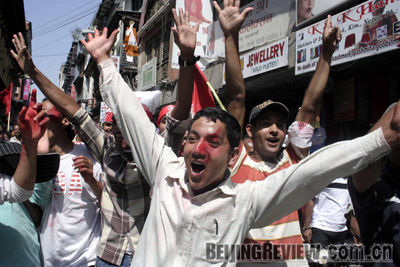|
|

|
|
NEW REPUBLIC, GREAT EXPECTATIONS: Nepalese celebrate in the capital city of Kathmandu on May 29, after the Constituent Assembly declared Nepal a republic the night before |
After being postponed in June and November last year, the Constituent Assembly election was held on April 10. Before the election, the Nepali Congress boosted its profile as it reunified with the Nepali Congress (Democratic). The Communist Party of Nepal (Unified Marxist-Leninist) was confident about its influence among the Nepalese. It was so sure of a victory that it refused to enter into an alliance with the Maoists so as not to be tainted by their guerilla history. No analysts inside or outside Nepal were optimistic about the Maoists’ chances in the election.
To everybody’s surprise, the Maoists defeated most senior leaders of the Nepali Congress and the Communist Party of Nepal (Unified Marxist-Leninist). They won 220 out of the 575 elected seats in the Constituent Assembly, compared to 110 seats for the Nepali Congress and 103 seats for the Communist Party of Nepal (Unified Marxist-Leninist).
There is no doubt that the Maoists’ triumph should be attributed to their excellent preparations and publicity efforts and the efficient operations of the party’s grassroots organizations. But the most important reason is that it has abandoned its radical policies such as rejecting foreign investment and promoted the goals of improving people’s livelihoods and eradicating poverty, visions that are highly appealing to the war-torn, poverty-ridden Nepalese. Given the other major political parties’ poor performance during their terms in office, Nepalese voters decided to give the Maoists, who label themselves “a real nationalist party,” a chance to put their ideas into practice. Nevertheless, they had their reservations. While making the Maoists the single largest party in the Constituent Assembly, they did not give it the majority it needed to dominate Nepal’s politics.
Political strife
The parties soon found themselves embroiled in an increasingly fierce conflict over the presidential election and the formation of the new government. This, in addition to the intervention of external forces, resulted in a political stalemate from May 28 to July 19.
In the first stage, major political parties failed to reach a consensus on the nomination of presidential candidates. The Maoists maintained that they should hold both posts of president and prime minister. The Nepali Congress insisted that Prime Minister Girija Prasad Koirala, the party’s president, should be the republic’s first president. The Communist Party of Nepal (Unified Marxist-Leninist), however, recommended its former General Secretary Madhav Kumar Nepal. The three parties rejected all candidates from other parties.
In the second stage, three Madhesi parties tabled a motion calling for the establishment of an autonomous region in south Nepal’s Terai Plains, which are populated by the Madhesi people of Indian origin. After the separatist motion was vetoed, Madhesi parliamentarians set about disrupting the meetings of the Constituent Assembly, rendering it unable to function for three weeks.
|
